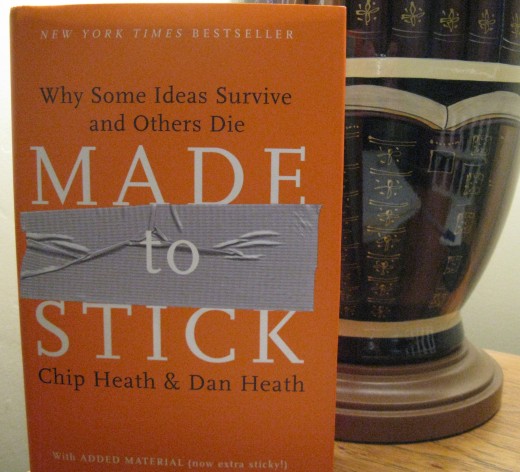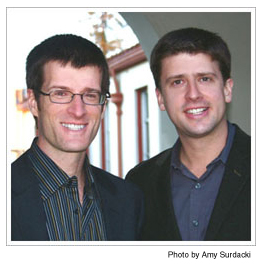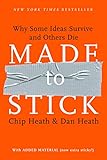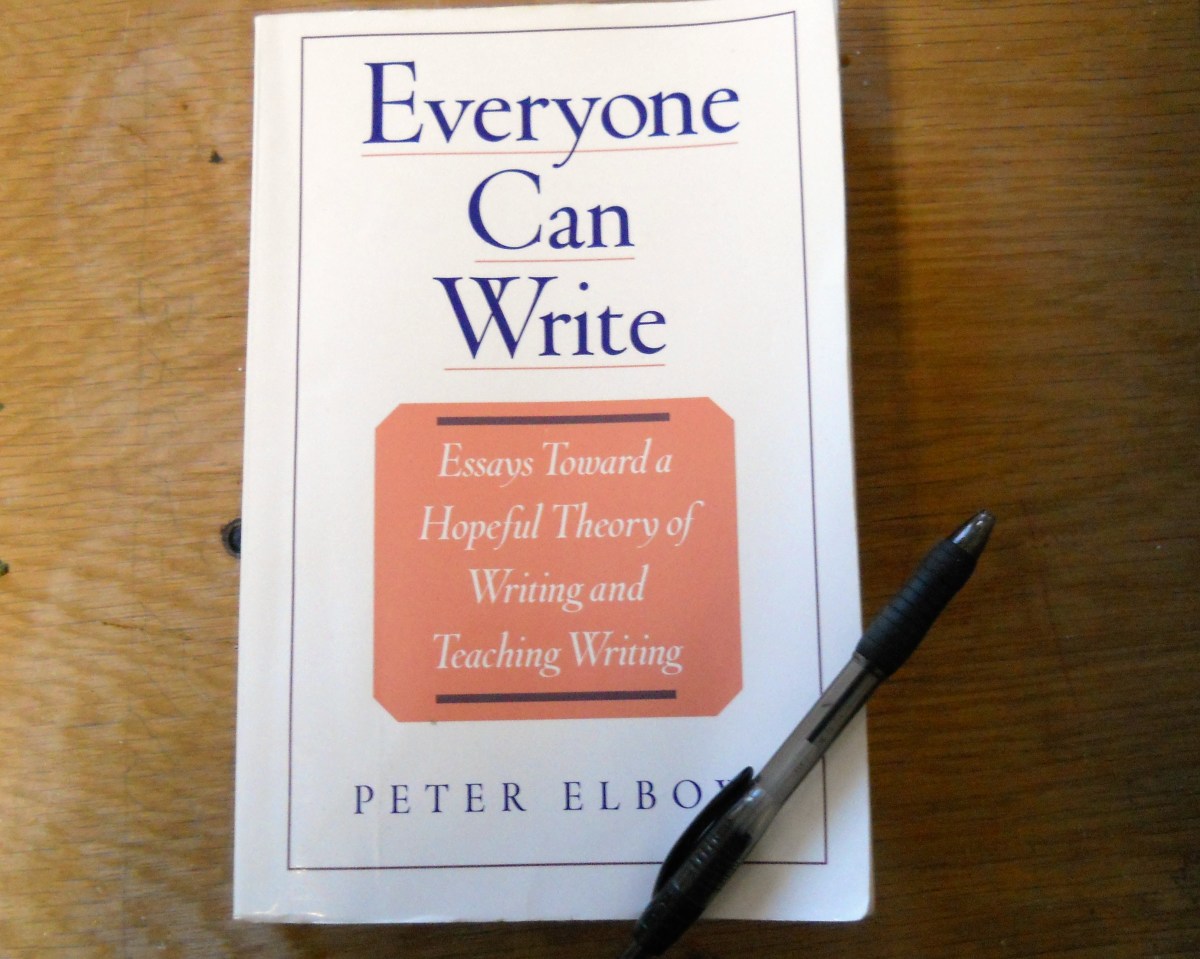MADE TO STICK by Chip Heath and Dan Heath


MADE TO STICK
MADE to STICK by Chip Heath and Dan Heath. Random House Books, 2007. Introduction, endnotes, index, Pp. 323. $26.00, hardcover.
While enjoying a couple of months off from teaching I have the privilege of reading some books that fall outside the typical genre that I'm drawn toward. Made to Stick caught my eye and so I thought I would read it and share a brief review of its contents with others.
The authors, if you didn't know already, are brothers.
Chip Heath: Chip Heath is Professor of Organizational Behavior and a faculty member of Stanford University school of business with a PhD in psychology. He had previously taught courses at the University of Chicago and Duke University. One of the courses he presently teaches is entitled "How to make ideas stick."
Dan Heath: Dan is a graduate of Harvard Business School and has a wide variety of experiences and accomplishments including his current position as a Fellow at Duke University's CASE center, a columnist for FAST Company magazine, a consultant to the Aspen Institute, and co-founder of Thinkwell, a college textbook publishing company.
Their book, Made to Stick, has been translated into 29 languages so far, and it is only 3 years old.
WHAT THE BOOK IS ABOUT
Made to Stickis a book that seeks to explain why certain ideas, concepts, slogans and statements tend to stick in our mind and impact our behavior, while others do not. They begin by citing various urban legends (the famous 'kidney heist' story, or the Halloween 'razor blades in apples' story for example) which spread so fast and were repeated to so often they have routinely been mistaken for the truth. They look at several enormously successful advertising campaigns which powerfully impacted the way people behaved and changed the way many people think. Those in my generation will remember the hilarious and impactful Wendy's commercials featuring the slogan "Where's the beef?" Some ideas just seem to be born "sticky!"
But why? Why does a particular message, a school lesson, a lecture, a commercial, a passage in a book (or maybe even a sermon) tend to stick in our mind for years...while others fade away almost immediately? Made to Stick attempts to answer that question, and in doing so, provides an instructive list of criteria that can be used to improve the chances of any idea "sticking" more effectively with our audience, whomever that may be.
Through research, and by comparing various "sticky" ideas, campaigns and phrases, Chip and Dan Heath constructed what they believe are the 6 common characteristics or features that many of these successful and "sticky" ideas share. These qualities of a sticky idea are related by means of a clever acronym: SUCCES which stands for:
- Simple
- Unexpectedness
- Concreteness
- Credibility
- Emotional
- Stories
SUCCES - Briefly Explained
A full chapter, generally 30-40 pages in length, is spent discussing and illustrating each of the 6 concepts involved in making a message "stickier." I can't do justice to any of these in the space of a brief review, but let me try to summarize in a single sentence what is meant by each of these concepts.
SIMPLE: By "simple" they mean that the message that hits to core concept, the main message, in a very few well chosen words. When George Bush said "No New Taxes" it stuck! Unfortunately for him it stuck so well it cost him the election. That is a simple message.
UNEXPECTIED: A message is stickier if it arouses curiousity by saying something contrary to common sense, breaks a known pattern or opens a mystery for the audience to ponder. For example, if I tell you that in your medicine cabinet is a drug you bought without a prescription and is responsible for 450 deaths per year...I think I would get your attention. You didn't expect that. I could then tell you it is Tylenol, and you would be far more likely to listen to me lecture on the safe use of Tylenol now that you know this fact. I told you something you didn't expect.
CONCRETE: An idea or concept destined for stickiness typically conveys something new by linking it to something we already know, preferable something very tangible that we can picture, smell, feel, etc. Proverbial wisdom tends to be communicated this way. "A bird in the hand is worth two in the bush" is a very visual way of communicating the danger of taking unnecessary risks. Franklin D. Roosevelt once remarked, concerning Adolf Hitler, "stroking a tiger will never turn him into a kitten." How he planned to deal with Hitler would "stick" because of concrete expressions like that.
CREDIBLE: What makes you believe a message? What makes a statement trustworthy? In this chapter Chip and Dan Heath explore the various ways to lend credibility to an idea and thus make it more "sticky." Credibility can be established without hiring a celebrity to endorse your idea. By making your idea "testable" by your very audience or listener you use their natural tendency to trust themselves to your advantage. "See for yourself" might be a good way to summarize this concept.
EMOTIONAL: Ideas are stickier that tend to evoke a strong emotional response. To quote the book "We show how our ideas are associated with things that people already care about (p. 203)." Emotions like anger, empathy, and honor tend to grip our hearts and make us respond. This chapter reminded me of the Old Testament event in which King David was confronted by the prophet Nathan about his adultery. Nathan, you may recall, told King David a story about a rich man who stole the sheep of a poor farmer, in order to feed his guest. David was outraged...Nathan hit upon an emotion! Then Nathan told David those piercing words "You are the man."
STORIES: The final element of a "sticky" idea or concept is to convey it with stories. Everyone loves a good story! In this chapter the authors explain some of the psychology of story-telling and how exactly they involve our listeners or audience.
MY IMPRESSIONS
As I mentioned at the beginning, books like this are not my typical fare. However, I was pleasantly surprised by how useful I found the information in Made to Stick. This was a fun book to read, filled with stories and illustrations collected from a variety of sources, and very entertaining.
One particular concept especially caught my attention, probably because I have seen it so often in pharmacy practice (as well as in virtually every professional field), known as "The Curse of Knowledge." No, the "Curse of Knowledge" has nothing to do with a tree in the Garden of Eden. It is a communication problem we are all liable to fall into. Michael McLaughlin, editor of 'Management Consulting News' interviewed Dan Heath about this. Dan said, during this interview, that the "Curse of Knowledge" is...
"a concept that psychologists and behavioral economists discovered in the early 1990s. They found that the more we know about something—the more expertise we have—the harder it is for us to imagine what it’s like to lack that knowledge. And that interferes with our ability to communicate what we know to others."
I have found this to be true in many different areas of life. While teaching pharmacy students I often had to remind them that certain terms and concepts which are natural to them, are entirely foreign to the average patient. This doesn't seem to be a problem limited just to professionals either. Everyone involved in any sort of communication has to overcome this at some point. The answer is not simply to "dumb things down" but rather to "find a 'universal language' that everyone speaks fluently (Made to Stick, p. 115)." The 6 concepts associated with "sticky ideas" help us to do just that.
MADE TO STICK
WHO SHOULD READ THIS BOOK
Well, I think this is a fun book for just about anyone. It may be especially helpful if you are involved in a communications career, advertising, or developing a product or idea of your own. Teachers, I believe, will enjoy many of the illustrations and practical advice included in this book. The latest edition of the book contains a special section at the end devoted to applying these "sticky concepts" to the area of teaching. Writers, bloggers, and anyone involved in public speaking should also take a look at it.
For more information on the book, visit the book's official website at: MADE TO STICK









